Advice from a Certified Hand Therapist: Protecting Your Hands During Workouts
As a hand therapist, my goal is to help people return to their previous activities after an injury. Many of my clients enjoy doing yoga and working out at the gym. These activities require good joint motion and tolerance for weight bearing through the hands and wrists. It is frustrating when pain limits participation in certain yoga poses or gym exercises. Or worse, people feel they are unable to return to these activities at all.
The following are some recommendations I make in the clinic for returning to physical activity after a hand or wrist injury:
Padded gloves with a wrist support strap
When gripping dumbbells and the handles of gym equipment, a padded glove with a wrist support strap can be helpful. The padding in the glove increases grip, softens the surface against the hand, and reduces slip, especially when sweating. In addition, the padding widens the grip a bit, which is better for the small joints of the fingers. The wrist strap provides support and increases the awareness of the position of the wrist.
Modify yoga poses and use props
Many people are unable to tolerate the yoga resting position of downward-facing dog because their wrists are stiff or lack full motion. There are other options for resting postures such as child’s pose (Figure 1) or puppy pose. Props, such as yoga wedges and bricks (Figure 2), may be used to change the position of the wrist. A yoga mat can be rolled to support the forearms or decrease the extreme angle of the wrist (Figures 3 and 4). A chair may also be used to lessen the load on the hands especially if there is weakness in the trunk (Figure 5).
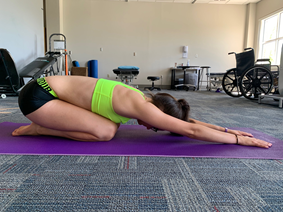
Figure 1
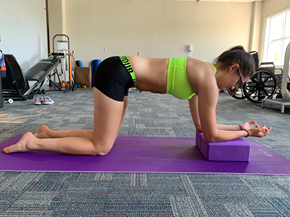
Figure 2
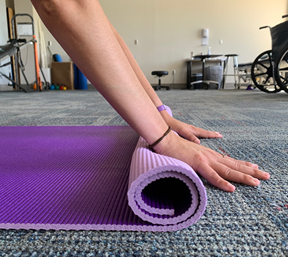
Figure 3
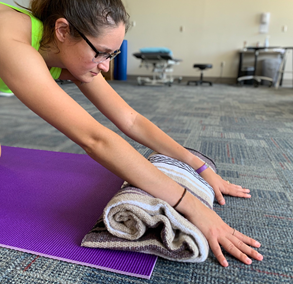
Figure 4
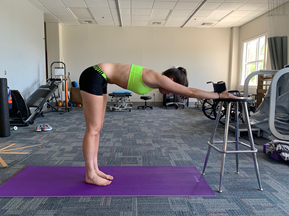
Figure 5
Use your body differently
When trying to place weight through the palms, spread the fingers wide to distribute the weight through the entire hand and keep the fingers active by slightly gripping the floor (Figure 6). Weight bearing on fists or forearms may be more comfortable than the flat palm (Figure 7). Take frequent breaks to stretch or rest. Avoid prolonged gripping when using dumbbells. Put the dumbbells down and stretch the hands wide between sets of exercises.
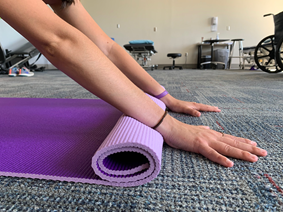
Figure 6
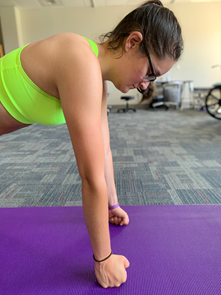
Figure 7
General self care is also recommended. This includes hydrating and avoiding holding your breath throughout the workout.
There are many creative ways to help you go back to the activities you enjoy. After a hand or wrist injury, if you have specific challenges trying to return your fitness routine, a hand therapist can help!
Stacy Hite, PT, DPT, MS, CHT is a certified hand therapist and a member of the American Society of Hand Therapists.
The following are some recommendations I make in the clinic for returning to physical activity after a hand or wrist injury:
Padded gloves with a wrist support strap
When gripping dumbbells and the handles of gym equipment, a padded glove with a wrist support strap can be helpful. The padding in the glove increases grip, softens the surface against the hand, and reduces slip, especially when sweating. In addition, the padding widens the grip a bit, which is better for the small joints of the fingers. The wrist strap provides support and increases the awareness of the position of the wrist.
Modify yoga poses and use props
Many people are unable to tolerate the yoga resting position of downward-facing dog because their wrists are stiff or lack full motion. There are other options for resting postures such as child’s pose (Figure 1) or puppy pose. Props, such as yoga wedges and bricks (Figure 2), may be used to change the position of the wrist. A yoga mat can be rolled to support the forearms or decrease the extreme angle of the wrist (Figures 3 and 4). A chair may also be used to lessen the load on the hands especially if there is weakness in the trunk (Figure 5).
Figure 1
Figure 2
Figure 3
Figure 4
Figure 5
Use your body differently
When trying to place weight through the palms, spread the fingers wide to distribute the weight through the entire hand and keep the fingers active by slightly gripping the floor (Figure 6). Weight bearing on fists or forearms may be more comfortable than the flat palm (Figure 7). Take frequent breaks to stretch or rest. Avoid prolonged gripping when using dumbbells. Put the dumbbells down and stretch the hands wide between sets of exercises.
Figure 6
Figure 7
General self care is also recommended. This includes hydrating and avoiding holding your breath throughout the workout.
There are many creative ways to help you go back to the activities you enjoy. After a hand or wrist injury, if you have specific challenges trying to return your fitness routine, a hand therapist can help!
Stacy Hite, PT, DPT, MS, CHT is a certified hand therapist and a member of the American Society of Hand Therapists.
Find a hand surgeon near you
Using this search tool means you agree to the user agreement and disclaimer.